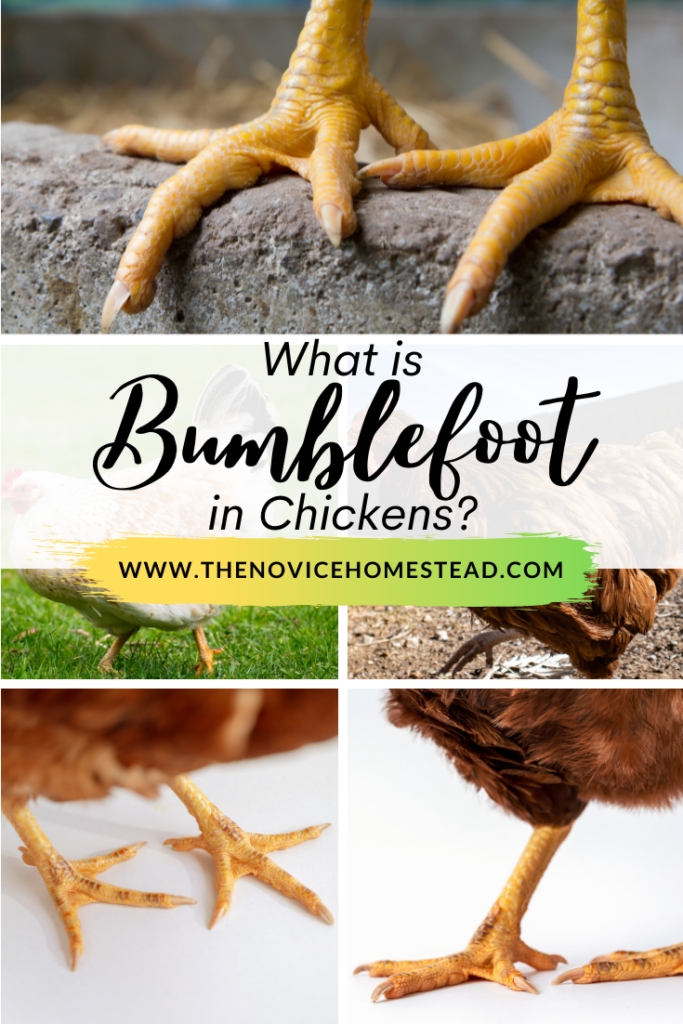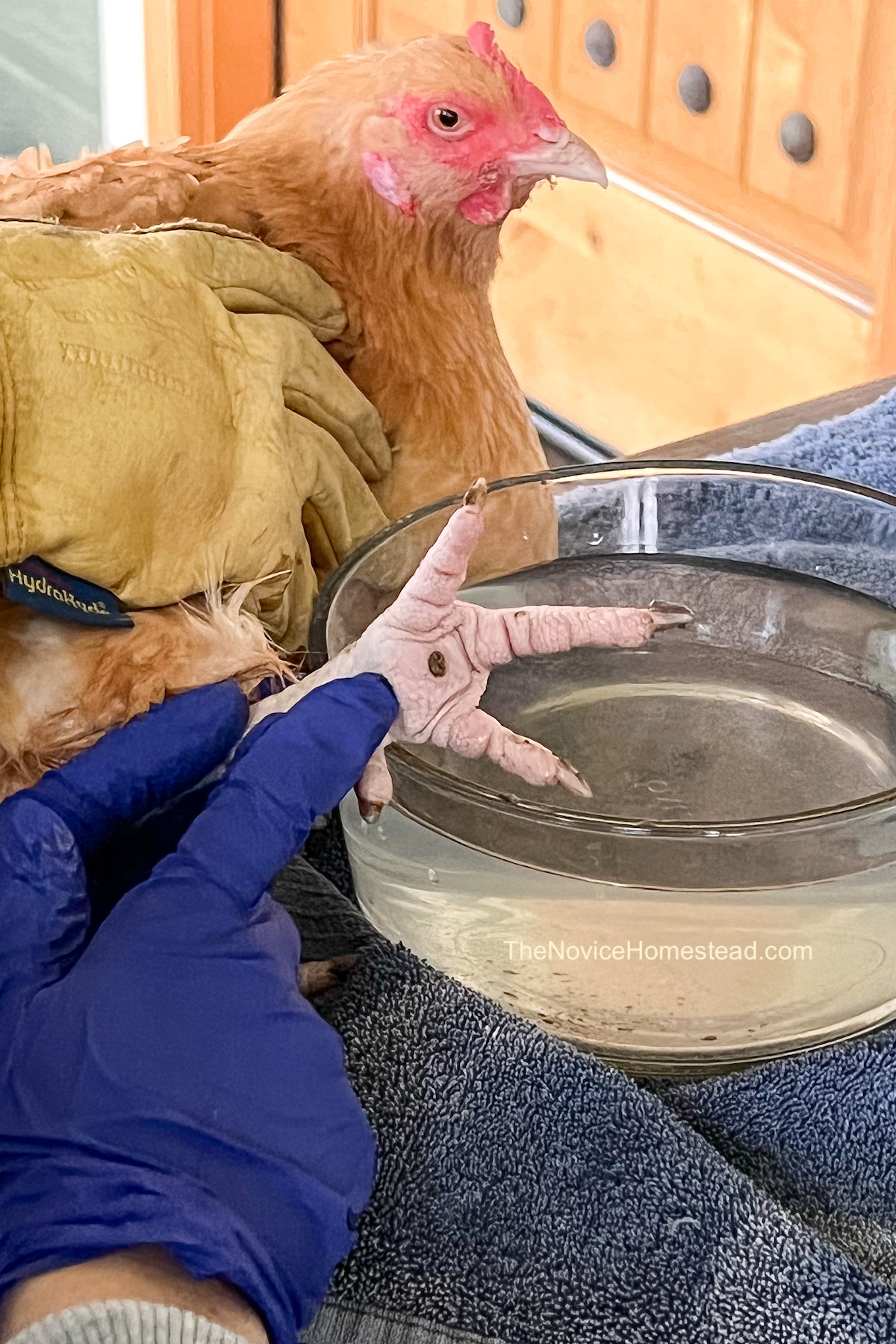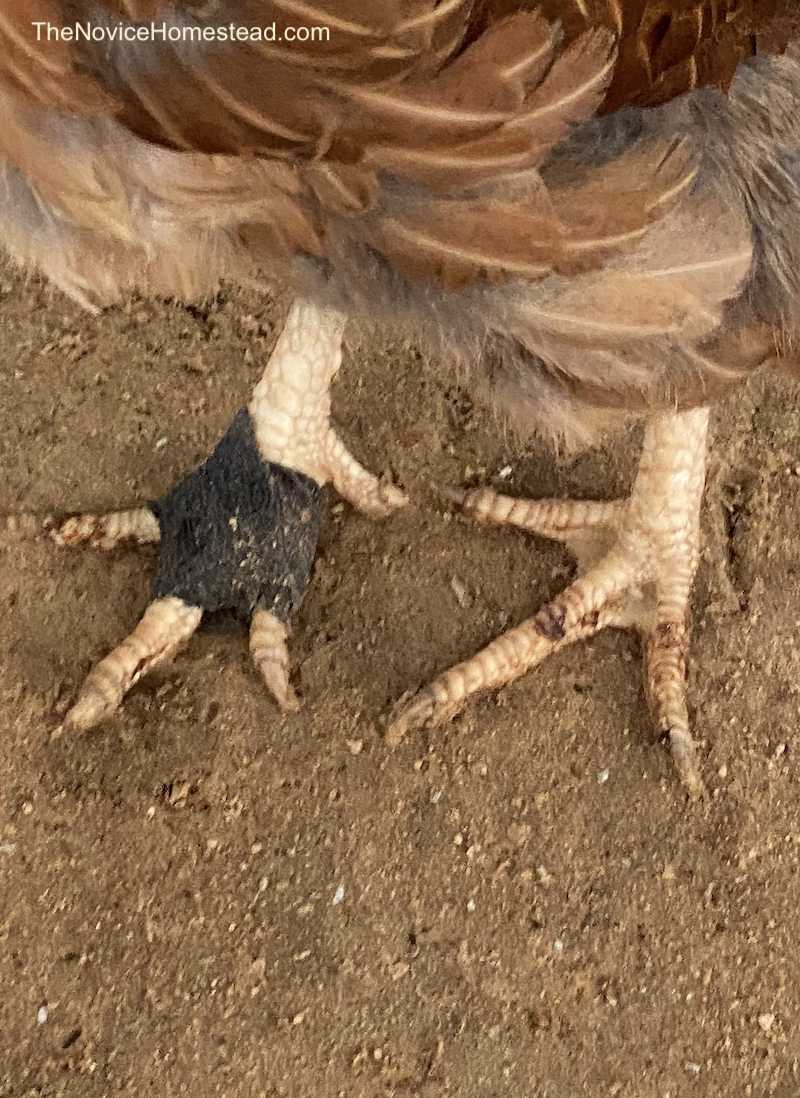Bumblefoot is an infection on the bottom of the feet in chickens. Keep reading for tips to identify and help heal bumblefoot.

What is Bumblefoot?
Bumblefoot is an infection that affects the feet of chickens. It generally appears as a black spot on the bottom of the chicken’s foot, so it may easily be missed at first. As the infection progresses, the bacteria forms an abscess — at this point you may notice swelling of the webbing between the toes of the chicken.
Bumblefoot can be difficult to treat, and it can lead to lameness, infection of the bones, and even death. So if you notice any signs of swelling, redness, or limping, you definitely want to take that particular chicken aside for a closer look.

What Causes Bumblefoot?
Bumblefoot is caused by bacteria that enters the skin on the bottom of a chicken’s foot, either through a cut or abrasion.
Bumblefoot is fairly common. In fact, I don’t think I know a single chicken owner who has not dealt with it at least once.
That being said, there are few things that can put your chickens at higher risk for developing bumblefoot:
- Hard surfaces: Chickens’ feet are designed for soft ground. When they have to spend an extended amount of time on hard surfaces, such as concrete, their feet can become sore or cracked. This opens the door to infection.
- Obesity: Obese chickens are more likely to develop bumblefoot because their weight puts more pressure on their feet.
- Jumping: Roosting bars that are more than two feet high means that the chickens have quite a jump to get down from them. This puts a lot of pressure on their feet when they land, which can cause injury.
- Splinters: Using tree branches with bark still on them as a perch might seem natural (chickens will sometimes perch on branches outdoors) but it can be hard on their feet. You want to make sure to use roosting bars that are fairly smooth, with no visible splintering. A splinter creates an entrance into the skin for bacteria.
How to Prevent Bumblefoot
There are a number of things you can do to prevent bumblefoot in your chickens, including:
- Keep your coop and run clean. This will help to remove any potential hazards that could scrape, puncture, or cut your chickens’ feet.
- Provide soft bedding for your chickens to walk on. This will help to protect their feet from injury. There are many different options for this; I personally use large wood shavings in the coop and sand in the run.
- Monitor your chickens’ weight. When chickens have layer feed as their primary food source or they free range, it is unlikely they will be overweight. Feed treats only in moderation.
- Check your chickens’ feet regularly for any signs of injury or infection. If you see anything that concerns you, act immediately.
How to Treat Bumblefoot in Chickens
First, I have to make it very clear that I am not a veterinarian. If you have a trusted livestock or poultry veterinarian, you may want to consult them.
The reality is that many of us do not have access to a vet that treats chickens. So the choice is to do nothing or to try to treat it yourself.
The first time one of my chickens had bumblefoot, I didn’t know what it was right away, so I searched out a local vet that treats “exotic” animals. (And yes, to all of the vets I called, chickens are considered “exotic.”) There was only ONE vet who would even look at my chicken and he was nervous to try to remove the bumble himself. He sent my chicken home with antibiotics and anti-inflammatory medicine.
The antibiotics took down the infection and the anti-inflammatory medicine got rid of the swelling. Her infection was fairly severe, so I think the antibiotics were life-saving in this case. However, the black bumble was still there on the bottom of her foot and I had to deal with that myself.
The good news is that you can absolutely take care of bumblefoot on your own if you know what you’re doing and have a few simple tools.
Do You Need Antibiotics To Treat Bumblefoot?
If you catch bumblefoot early enough, you may be able to treat it without antibiotics. Giving antibiotics to a chicken means they need to be isolated, so you can assure that no one else is getting the medicine and that they get the correct dose. It also means you can’t eat the eggs for a certain amount of time, which may depend on the medicine given.
However, if the infection has processed to the point where there is noticeable swelling on TOP of the foot or the foot feels hot to the touch, you may need antibiotics to stop an advanced infection and save your chicken’s life.
Even with antibiotics, you will still need to remove the bumble, clean the wound, and bandage the foot. Below I’ll explain how I did so with my birds.
How to Get Rid Of Bumblefoot
Since I’m not a vet, I can’t advise on what you should do, but I will outline the steps that I take to heal bumblefoot in my chickens whenever it pops up.
These are the tools I used:
- Gloves – It is always a good idea to have a box of these gloves on hand!
- A clean workspace
- Non-stick antibacterial wound pads
- Self-adhesive bandage – You may need to cut the bandage into smaller strips.
- Poultry wound spray
- Sturdy bowl of warm water
- Salt
- Oregano essential oil
I always have my husband hold the chicken for me, rather than trying to do this on my own. It is a LOT easier and safer to work when you have both hands free.
- First I put on gloves.
- Next I take the affected foot and soak it in a solution of warm salt water with 1-2 drops of oregano oil. This helps loosen the skin and the salt and oregano oil both are said to have healing properties.
- After a few minutes, I take out the foot and gently turn it so I can better see the bottom of the foot.
- I start at the edge of the black spots and gently pull it out of the foot. It’s kind of like picking a scab, except the bumblefoot generally will not bleed. However, chickens don’t usually love this part, so I work quickly and carefully.
- The bumble should kind of pop out and it is about the size of a corn kernel.
- I always check the abscess to make sure that there is no puss or other goop inside.
- If there is any goo inside, I carefully squeeze it out. But I never squeeze to the point that it makes the chicken appear to be in pain or to make the foot bleed. I’d rather not hurt them, and I can always re-examine and clean further in a few days if needed.
- Once the wound is clean and dry, I cover it with a small square I cut from a wound dressing pad. Just enough to cover the abscess but not get wrinkled or wrap up the sides of the foot.
- I use 1-inch wide strips of self adhesive bandage to wrap the foot, working around the toes…but not pulling the bandage tight. It’s important not to cut off circulation. If this is your first time wrapping a foot, check your chicken about 20 minutes later to make sure they are walking ok. They may pick at the bandage at first, which is normal, but they shouldn’t limp worse or act like the bandage is hurting them.
- Tuck in the end of the bandage and press down so it sticks to itself.
Here’s a look at one of my girls wearing her bandage. It’s been on for a couple days and the vet wrap stays on really well. Excuse her feathers…she is molting.

Best case scenario, I caught the infection early and when I check the foot a few days later it has healed. No further treatment necessary.
One of my girls had a very persistent infection, and her treatment took months. Yes, months. I cleaned and changed the bandage weekly until the bumble stopped re-forming. It was a lot of work, but it saved her life and she is still happy out there bossing around the flock!
Learn More About Parasites and Illnesses In Chickens
More Tips For Raising Backyard Chickens:
- Guide to Raising Baby Chicks
- What is Pasty Butt in Baby Chicks?
- When Do Chickens Start Laying Eggs?
- How Often Do Chickens Lay Eggs
- Is Free Ranging Better for Chickens?
- How Cold is Too Cold for Chickens to be Outside?
- Farm Fresh Eggs 101
- How to Keep Chickens Cool in the Heat
- How to Keep Snakes Out of a Chicken Coop
- How to Stop Chickens From Eating Eggs